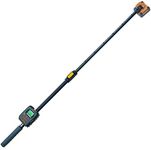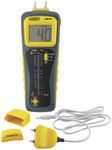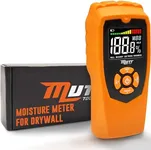Buying Guide for the Best Moisture Meter Woods
Choosing the right moisture meter for wood is crucial for ensuring the quality and longevity of your woodworking projects. A moisture meter helps you measure the moisture content in wood, which is important for preventing issues like warping, cracking, and mold growth. When selecting a moisture meter, consider the type of wood you are working with, the accuracy you need, and the specific features that will make your work easier and more efficient.Type of Moisture MeterThere are two main types of moisture meters: pin-type and pinless. Pin-type meters use two pins that are inserted into the wood to measure electrical resistance, which correlates with moisture content. These are generally more accurate but can leave small holes in the wood. Pinless meters use electromagnetic sensors to measure moisture without damaging the wood. They are faster and easier to use but may be less accurate on very dense or very thin wood. Choose a pin-type meter if accuracy is your top priority and you don't mind minor damage to the wood. Opt for a pinless meter if you need quick readings and want to avoid damaging the wood surface.
Measurement RangeThe measurement range indicates the range of moisture content that the meter can detect, usually expressed as a percentage. This is important because different types of wood have different acceptable moisture levels. For example, hardwoods typically have a lower acceptable moisture content than softwoods. A meter with a range of 5-30% is usually sufficient for most woodworking projects. If you work with a variety of wood types, choose a meter with a broader range to ensure it can handle all your needs.
AccuracyAccuracy refers to how close the meter's readings are to the actual moisture content of the wood. This is crucial for ensuring the quality of your work. Higher accuracy is generally better, but it can also make the meter more expensive. Look for meters with an accuracy of ±1% to ±2% for most woodworking projects. If you are working on high-precision projects, such as fine furniture or musical instruments, you may want to invest in a meter with even higher accuracy.
Depth of MeasurementDepth of measurement indicates how deep into the wood the meter can measure moisture content. This is important for thicker pieces of wood where surface moisture may not be representative of the entire piece. Pin-type meters usually measure at the depth of the pins, while pinless meters can vary. For general woodworking, a depth of 1/4 to 3/4 inch is usually sufficient. If you work with very thick wood, look for a meter that can measure deeper.
Display and ReadabilityThe display and readability of the moisture meter are important for ease of use. Look for a meter with a clear, easy-to-read display that shows the moisture content in a way that is easy to understand. Some meters have backlit displays, which can be helpful in low-light conditions. Others may have additional features like hold functions, which allow you to freeze the reading on the display, or auto-calibration, which ensures the meter is always providing accurate readings. Choose a meter with a display that you find easy to read and understand, and consider any additional features that might make your work easier.
Durability and Build QualityDurability and build quality are important for ensuring that your moisture meter will last and perform well over time. Look for meters made from high-quality materials that can withstand the rigors of a woodworking environment. Some meters are also water-resistant or have protective cases, which can be useful if you work in damp or dusty conditions. Choose a meter that feels solid and well-built, and consider any additional features that might enhance its durability.






















